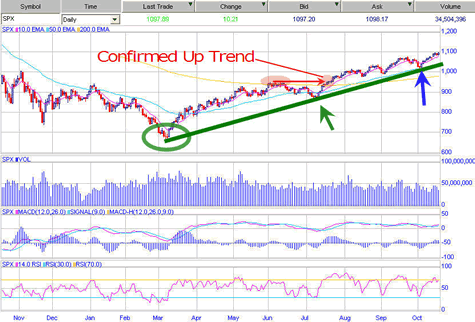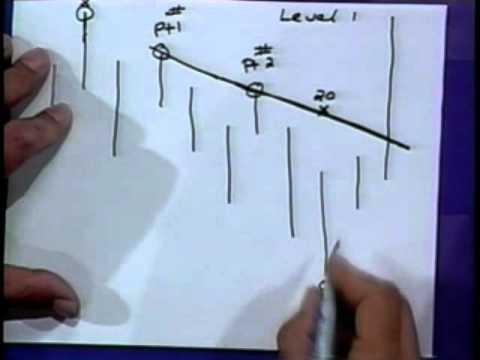Trendlines Use Trendlines to Predict the Market s Next Move
Post on: 3 Июль, 2015 No Comment

When charting stocks, identifying trendlines is where it all begins
Use Trendlines to Predict the Markets Next Move
Ive received a lot of basic technical analysis questions lately, especially about how to tell if a stock is going to move higher or lower, or stay flat.
So I want to cover one of the most basic, most important and, often, most overlooked concepts of technical analysis: the trendline.
Back to Basics
When charting stocks, exchange-traded funds (ETFs), futures, commodities, currencies or the market, identifying trendlines is where it all begins.
Simply stated, the trend is the direction that the market is moving in. The markets trends are characterized by a series of zigzags that resemble a series of waves with peaks and troughs. The direction of those peaks and troughs is what signifies a trend.
There are three trends:
- Uptrends
- Downtrends
- Horizontal trends
An uptrend shows a series of higher peaks (highs) and higher troughs (lows). A downtrend shows a series of lower peaks, and lower troughs.
A horizontal trend (aka, a neutral trend) shows horizontal, or equal, peaks and troughs, and reflects a period of indecision. This is also known as the consolidation phase. Stocks or indices trade sideways as the bulls and bears slug it out, and eventually the previous uptrend or downtrend continues, or moves in the opposite direction.
Relationships Among Trends
When studying charts, youll find that there are many different trends all existing at the same time. Youll find that some trends tend to overlap each other. And youll find trends within trends within trends.
For example, after identifying a long-term trend, you will find intermediate-term trends within it. When you zoom in, youll find short-term trends within the intermediate trends, and so on.
Every trend is a small part of the next larger trend.
One mistake many people make is that they fail to realize the enormous importance of identifying the trend of the time period that they are trading in as well as the next larger trends.
Indentifying the larger trends gives you a much clearer perspective. Its like driving across the country and, not only looking at a map of the town youre in, but also looking at the map of the state, and then the country.
The larger trends have a major impact on the smaller trends within them. Therefore, whatever trend you are using for timing purposes (intermediate, short-term, etc.), you must always determine and trade in the direction of the next longer trend.
Another analogy is that its like having to guess what the weather will be like in three days from now (without any help from the media). Knowing whats happened in the last few days is a big help. Knowing what season youre in is definitely going to help. (And knowing what part of the world you are in helps, too, but that is a good analogy for discussing the difference between different sectors.)
Profit No Matter Which Direction a Stock Moves
You can profit from a securitys decline (with bearish positions like short-selling a stock or buying a put option ) or from an advance (with bullish positions like buying a stock or a call option).
You should buy a security (or, what I prefer to do is buy a call option on the security) when the market is oversold in an uptrend, and sell short a security (or, what I definitely prefer is to buy a put option on the security) when the market is overbought in a downtrend.
Its just as easy to profit from stocks or indices that do nothing but trade flat, using very simple options strategies, as it is to profit from an increase or decrease in volatility.
When Youre Ready to Start Charting
Repeating myself is probably even more annoying for me than it is for you, but I cant stress to you enough how important this is, so Ill repeat it: Whatever time frame you are looking at when viewing a chart, you must zoom in and zoom out.
Zoom out to identify the direction of the next larger trend, and the next one after that.
Zoom in to time the best execution on your trades.
I find that the best way to approach the trading process is to start with the long-range charts (with a time frame of several years) and then work your way toward the shorter-term charts (like one-year charts, and then move to six-month and three-month charts).
Its also helpful to start with monthly and weekly charts for the longer-term view. Then check out the daily chart, which will be the chart that you base your trading decision on.
Then, for even-more-precise timing (i.e. finding the best time of the DAY to enter your trade), check out the intraday chart. Checking the intraday chart is especially useful when trading options, where a 2% movement in the stock could mean a 10% difference on the option.
So if you think youve found a good trade based on the chart, zoom in and out.

The definitions of the different trends time frames tend to be ambiguous. Lets start with the three basic trends that well be focusing on.
- Near-term trend (aka, short-term trend) = days to weeks
- Intermediate trend = weeks to months
- Long-term trend (aka, major trend) = months to years
Many will argue that Dow Theory, which is the cornerstone of the study of technical analysis, suggests that the major trend is defined as more than one year.
In the late 1800s, Charles Dow proposed a great deal of the theories of technical analysis that exist today. (Respect to Chuck.) But since people these days cant seem to agree on the definition of each of the time frames, well go with what the average technician will say, and well keep in mind that they are ambiguous terms.
Profit From The Trend
Remember the law of physics: A body in motion tends to stay in motion until a force or obstacle stops or changes that motion.
The reason for charting is to identify trends early and act on them by trading in the direction of that trend. The idea is not to try to anticipate what the market will do next but, instead, to simply go with what the market is currently doing.
The focus should not be on why the market is doing what its doing, but on what is occurring. It should be on where prices are in relation to the current trend.
The mistake that many traders make is that they anticipate or guess what the markets next direction will be. Charts show us the markets current condition.
They reveal pictures of bullish or bearish psychology, and they show us a picture of human nature that doesnt change. This is why, when it comes to charts, youll find that history repeats itself. And thats why the key to coming as close as we can to knowing the future is in understanding where we are in relation to the past.
If you can correctly interpret exactly what the market is telling you and act swiftly, youll become more and more comfortable and confident with experience.
The first step in reading charts is in understanding where the key levels of support and resistance are found, and thats why trendlines are so important.
On Oct. 5, we were pretty certain the stock market would stop selling off (reversing lower), and would reverse back up and move higher.
How did we know this?
Well, you can see the bear market bottomed out (at least, we think so) in March. We simply extended the (green) line from that March low to the following low made in July (green arrow).
The low in July did NOT tell us we had a CONFIRMED uptrend line until the recent peak was penetrated (red arrow and red circles showing the high that needed to be broken before its a confirmed trendline).
Then came the recent sell-off. People were nervous. But on Oct. 5, the market told us it wasnt finished with the advance yet when it bounced off the trendline (blue arrow).
There is a lot more to learn in technical analysis. Its important to use these indicators in conjunction with one another. (That is, dont base trades solely off the trendlines). But this is your starting point.
Its really not that difficult and, once you get the hang of it, youll be banking profits like you never imagined possible.
This market is packed with opportunities to make big money … if you know where to look. Find the hidden money-doublers in todays stock market. Learn more in your FREE Options Report .
investorplace.com/2009/10/use-trendlines-to-predict-the-markets-next-move/.














